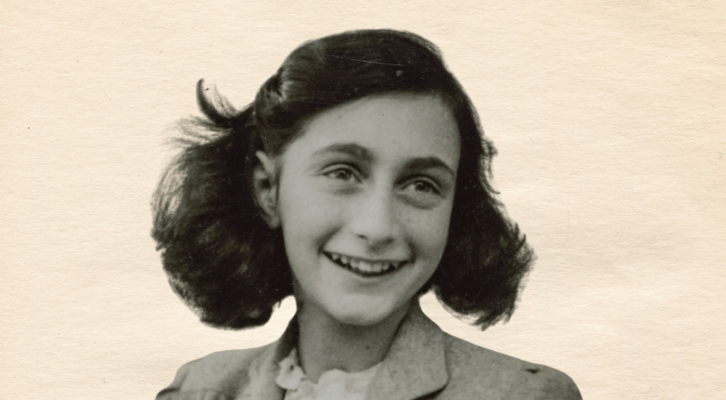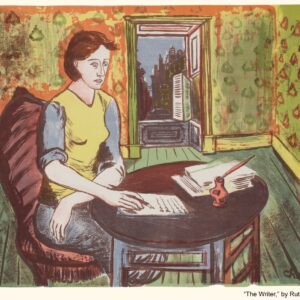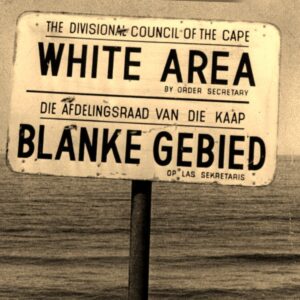
On the Venerated—and Exploited—Legacy of Anne Frank
Lola Lafon on Spending the Night in the Annex of the Anne Frank House
It’s her. A silhouette at the window, emerging from the shadows, just a girl. She learns over the ledge, drawn, no doubt by laughter she’s heard in the street: it’s coming from an elegant procession of people in satin gowns and gray suits.
She turns around, seems to be calling to someone. A wedding! Come and see! Impatiently she summons them again. Come quick! It’s all so beautiful—the gleaming fabric, the lustrous chignons. There she is, on the second floor of a nondescript building, a small silhouette stepping into history, accidentally caught by the camera as it pans up.
She is full of life. We see her hopping up and down, although we have only previously seen her frozen in place, in black and white photographs.
She is twelve years old. She has four years left.
These are the only moving pictures of Anne Frank. Silent images, taken from an amateur film made in 1941, doubtless by someone close to the bride or groom. Seven seconds of life—barely a glimpse.
How loved she is, this young Jewish girl who is no longer. The only young Jewish girl who is loved so madly. Anne Frank, imaginary sister to millions of children, who, if she had survived, would be their grandmothers’ age. Anne Frank, the eternal adolescent, who today could be my daughter, if people always stayed how old they were when they died.
Anne Frank, whom the world knows so well while knowing very little about her. An image: that of a pale young girl, hair sensibly fastened with a barrette, sitting at her desk, a pen in her hand. A symbol, but of what? Adolescence? The Holocaust? Writing?
What term can we use to refer to her famous diary, which every schoolchild has read and which no adult truly remembers? Is it testimony, evidence, literature? Perhaps it’s a deposition from a young girl imprisoned to keep her alive, whose words will eventually break free.
A young girl who, for seven hundred and sixty days, could only travel up and down a staircase, whose entire world was less than forty square meters.
Songs have been dedicated to her, and poems, novels, requiems, and symphonies. Her face has appeared on stamps, mugs, and posters; it has been graffitied on walls and engraved on medallions. Her name can be found on the front of hundreds of schools and libraries and was bestowed on an asteroid in 1995. Her writings have been added to UNESCO’s Memory of the World register, alongside the Magna Carta.
In 2021, she made front-page news in the Netherlands: in Amsterdam, opponents of the Covid-19 vaccination passport brandished her portrait, chanting “Freedom, freedom.”
Anne Frank: venerated and exploited.
On August 18, 2021, I spent the night at the Anne Frank House, in the museum’s Annex.
I went in order to perceive space, since we cannot perceive time. We cannot explain to ourselves the weight of an hour, the density of a week. How to imagine what twenty-five months of life felt like for eight people hidden in this cramped place?
So, all night long, I will pace from one room to another, from her parents’ bedroom to the bathroom, from the attic to the small common area, and I will count the steps Anne Frank had available to her. So few steps.
What should we call her? I say Anne, but this false intimacy makes me uncomfortable. I can’t say Anne, something blocks me, a thing that will materialize and make it impossible for me to enter her bedroom. So I say Anne Frank, as if taking attendance, as if to call on the once-brilliant student of a phantom junior high. Two syllables.
I thought of the night I would spend there as a kind of meditation, a silence. I imagined the night as a suitable time to acknowledge Anne Frank’s absence. I prepared myself to be attuned to the void, to receive it.
I was mistaken. The night was inhabited, lit by reflections; some urgency still dwelled at the heart of the Annex, crouched there, ready to be discovered.
May 2021. Like Paris, Amsterdam is still partly under lockdown. My interview with the director of the museum, Ronald Leopold, takes place on screen. The conversation is crucial: he alone can authorize me to spend the night in the Annex. We talk about this and that, as a way of getting to know each other. Although he is glad Anne Frank and her story still mean something to people, he is sorry that all this adoration overshadows her writing.
Some people come every year, and have done for decades, to commune with her in her room. They leave letters, stuffed animals, rosaries, candles. It is not uncommon for a visitor to refuse to leave the Annex, convinced she is Anne Frank reincarnate.
This degree of identification perplexes the director. Calling her by her first name, as some of his colleagues do, troubles him as well.
Of course, working at the museum every day creates a kind of proximity to her, but Anne Frank is neither a family member nor a friend.
While we’re on the subject, he is by no means interested in making me fill out a questionnaire, but he would like to know: what does she represent for me?
I act as if my project were the fruit of a rational decision. I speak in a detached tone about my work, the young girls at the center of my novels: they all challenge the spaces they are allowed to occupy. All of them have seen their stories misinterpreted and rewritten by adults.
__________________________________

When You Listen to This Song: On Memory, Loss, and Writing by Lola Lafon and translated by Lauren Elkin is available from Yale University Press.
Lola Lafon
Lola Lafon is a French writer who grew up in Eastern Europe and studied dance and music in Paris and New York. Her prizewinning books include The Little Communist Who Never Smiled and Reeling: A Novel. She lives in Paris, France. Lauren Elkin is a French and American writer and translator. She is the author of several books, including Flâneuse and Scaffolding, and lives in London, UK.



















